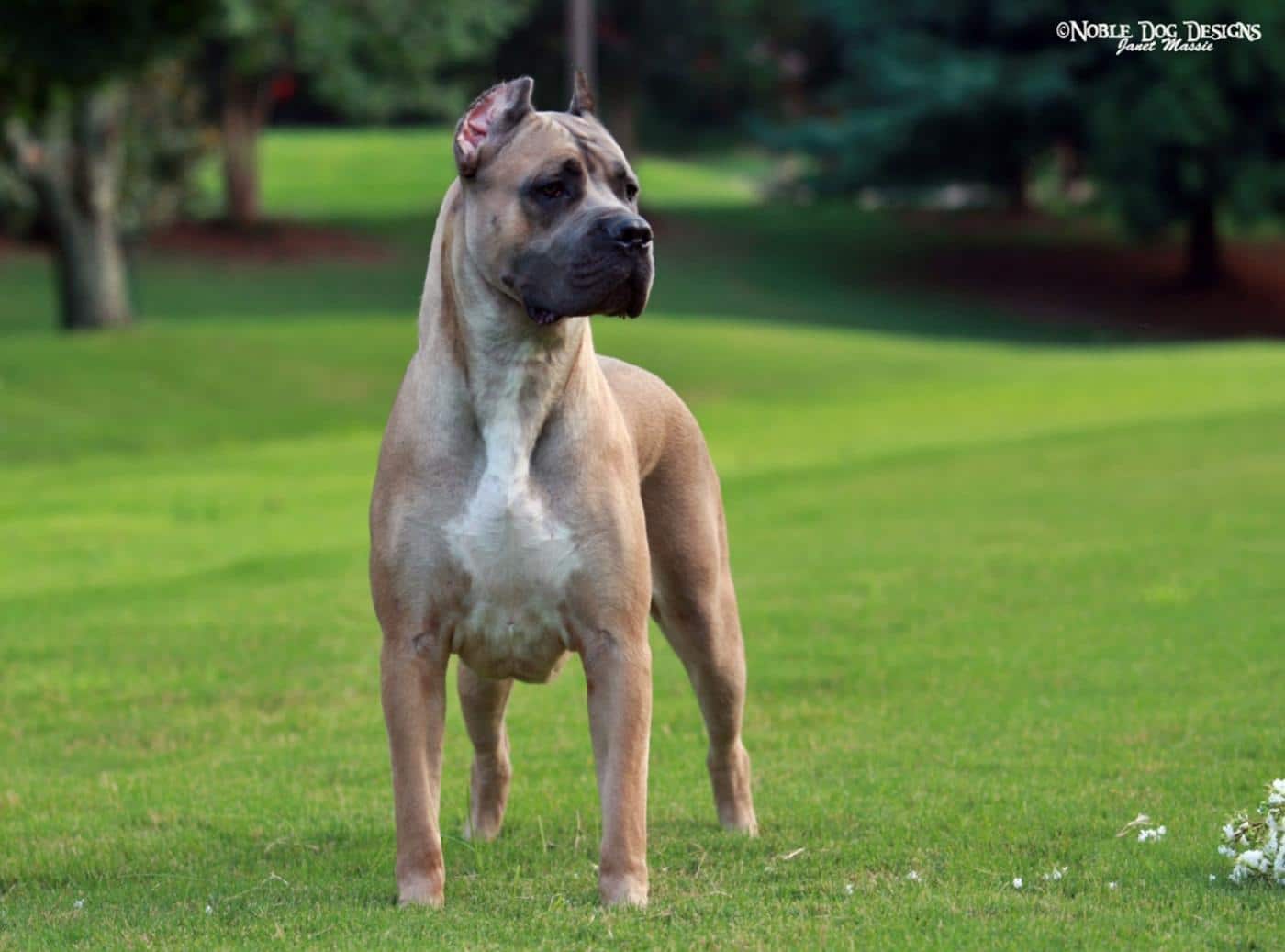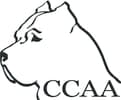The lack of consistency continues to be a major problem in the Cane Corso Dog Breed. We believe the lack of education and the misunderstanding of breed traits is a significate factor. Therefore, the Breed Education department of the CCAA has put together some points that may help judges and the fancy sort out problem areas.
Correct muzzle length: It’s not what you think!
The standard calls for a 1:3 ratio, yes. But this measurement is often misinterpreted as the “Midpoint.” That is incorrect. The 1:3 is a boundary measurement put in place to guard against excessively short muzzles. If the muzzle is shorter than 1:3, it changes expression, causes the convergence to be extreme, and is associated with excessive undershot, round/bulging eyes, and pinched nares. In a nutshell, a muzzle that is too short fundamentally changes the head type; and this head type, however popular or common, is not correct.
This concept is clear when we review our breed history. During the recovery, many examples of Cane Corso farm dogs were measured and cataloged. As a result, a dog named Basir was determined to have the ideal muzzle. His muzzle measured 38% of his overall head length. That is 5% longer than the boundary in the standard. So, as you evaluate muzzle length, remember history; 33 to nearly 40% is correct Corso type. Anything shorter will typically lack correct breed head type.
Anterior face of the muzzle is flat: Nothing should be sticking out!
There is always a lot of talk about which bite is correct for the Cane Corso. Almost always a muzzle with the correct front will always accompany a functional bite. Here’s the trick; when viewed from the side, the line from the nose down to the chin is perpendicular. The definition is critical here. Perpendicular lines are defined as two lines that meet or intersect each other at right angles (90°). So, the nose appears as the top “corner” for front of the muzzle and the horizontal line of the bridge of the muzzle. The chin is the bottom “corner” for the muzzle front and the horizontal jawline. The nose should not stick out over the chin and the chin should not jut out beyond the point of the nose; neither is prominent.
Slight Convergence: No dome foreheads or ski slopes, please
The parameters defining the space between the stop and occiput (little bump at the back of the skull between the ears) may be one of the breed’s most misunderstood. Over the years, and with the shortening of the muzzle, we have seen a radical change in the shape and incline of the forehead. A change that has made correct convergence uncommon. We must retrain our eyes.
When viewed from the side, the skull gradually flows back from the pronounced brow and slightly inclines toward the back skull. The forehead does not ascend directly up from the brow. The forehead’s side profile should not bulge or be rounded, like a football helmet. If the slope of the forehead is steep and is at an angle suitable for skiing, this is a clear sign of outside breed influence. *Note: No convergence will exhibit parallel planes, which is also unacceptable.
Well-defined Stop. Put your thumb in it
Cane Corso eyes are wide-set. They have a pronounced brow that serves as a protection for the slightly inset eye. From the side, the stop looks kind of like a step from the horizontal muzzle bridge to the forehead that slopes gradually back from the brow. When viewed from the front, there is a distinct depression between the wide-set eyes. This well-defined depression should be wide and deep enough for your thumb to easily rest down into it.
Distinctly rectangular in proportion. If you think it might be too square…it is!
Correct length of body is a critical component to function in the breed. When the front and rear assembly are put together correctly, the Cane Corso is capable of extended reach and drive, allowing it to cover ground most efficiently. Short backed Corso often take shorter steps or are forced to turn their bodies sideways to move correctly. Ten percent body length is a boundary measurement to protect the breed from becoming too “square.” Most Corso that travel in an elongated trot are longer and certainly fall within the parameters of correct breed type.
Elbows sit directly under the withers. Short upper arms belong to a T-Rex, not a Cane Corso
The correct configuration of the Corso’s front end is exceedingly essential. The weight of the large head, powerful neck, and muscular chest account for over 60% of the total mass of the dog. That mass bears down on the front, and if that weight is not evenly distributed, injury is likely, and performance is affected. Short upper arms and straight shoulders are becoming commonplace in our breed. This poor structure places tremendous strain on elbows and shoulders and pasterns. It restricts reach and often creates a pinched, narrow chest.
Corso shoulders are well laid back, the upper arm is of comparable length to the scapula and that elbow sits directly beneath those withers. When viewed from the side, the correct front assembly creates a vertical, even line of weight distribution from the withers down to the elbow, down the leg, pastern and rests squarely on the pads of the foot, not the toes!
Balanced rears—All things being equal
Just as the front end of the Cane Corso should be built to distribute weight evenly, the muscular rear is configured for correct weight placement, and is capable of powerful drive and quick direction changes. This is accomplished when the bones, the pelvis, both thighs and hocks, are of similar length; creating moderate angulation.
We often see long thighs and short hocks in the Corso. This incorrect framework places a tremendous amount of weight on the knee. A correct, moderate hock bears the brunt of quick direction change. Moderate angulation, along with a moderate pelvis tilt and balanced rear, is critical to the breed’s ability to function. Properly built, the massive rear end is less susceptible to knee and hip injuries.
Elongated trot/Extended reach and drive—high headed, prancing ponies need not apply
Envision rippling muscle and substance, covering significant ground with an effortless, elongated trot. He carries his massive head down and forward as he glides; topline rigid and level. He takes long, clean strides, utilizing his energy efficiently. His movement is smooth, aerodynamic and almost surprising considering his mass. Short, delicate steps and head held high may be flashy, but it’s not correct for a Cane Corso.
Size and substance
The Cane Corso is a perfect blend of bone, substance, stark muscle definition and athletic ability. Static, he gives the impression of mass and power. In motion, he moves with efficiency. He is never sloppy or cumbersome. When asked what size a Corso should be, the answer should be something like this: “Athletic enough to run tirelessly after large, formidable game; substantial enough to dispatch it once he arrives.” There is nothing about the breed that says fine bone or sloppy couch potato.
His presence—a note to judges
Powerful and imposing? Truly distinct characteristics of a Cane Corso stacked and waiting for examination. A judge that wishes to see the dog at his full potential should remember the least amount of intrusion by a stranger accomplishes this best. Here are a few helpful tips:
A judge should not expect a mature Cane Corso to be a “wag and greet” kind of dog. An obedient, stoic participant is more than acceptable from this Guardian breed.
Always approach from the front, avoiding imposing stares into the dog’s eyes. A judge should not expect a mature Cane Corso to be a “wag and greet” kind of dog. An obedient, stoic participant is more than acceptable from this Guardian breed. However, stoic should not be confused with “asleep at the wheel”. A Corso should be alert and watchful at all times. His expression should be distinctly intelligent. Fearfulness or aggression is not acceptable.
Greet the handler first and ask them to show the bite when the time comes. Limit extensive, heavy-handed exams. If a puppy seems apprehensive, make it fun.
The Cane Corso is very sensitive to his surroundings and is quick to pick up on unsettling situations. Anyone who is apprehensive about the breed should not judge them.
Article courtesy of: CANE CORSO ASSOCIATION OF AMERICA BREED EDUCATION









